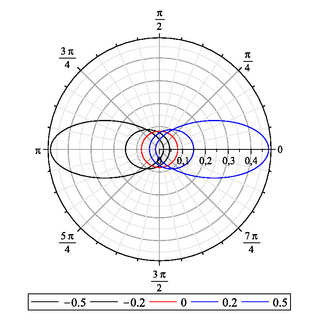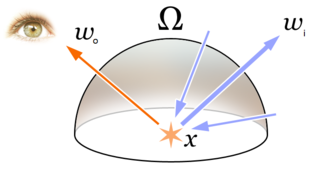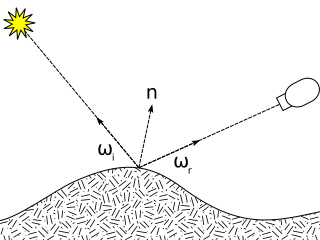Related Research Articles

Rendering or image synthesis is the process of generating a photorealistic or non-photorealistic image from a 2D or 3D model by means of a computer program. The resulting image is referred to as the render. Multiple models can be defined in a scene file containing objects in a strictly defined language or data structure. The scene file contains geometry, viewpoint, texture, lighting, and shading information describing the virtual scene. The data contained in the scene file is then passed to a rendering program to be processed and output to a digital image or raster graphics image file. The term "rendering" is analogous to the concept of an artist's impression of a scene. The term "rendering" is also used to describe the process of calculating effects in a video editing program to produce the final video output.

Global illumination (GI), or indirect illumination, is a group of algorithms used in 3D computer graphics that are meant to add more realistic lighting to 3D scenes. Such algorithms take into account not only the light that comes directly from a light source, but also subsequent cases in which light rays from the same source are reflected by other surfaces in the scene, whether reflective or not.

In 3D computer graphics, radiosity is an application of the finite element method to solving the rendering equation for scenes with surfaces that reflect light diffusely. Unlike rendering methods that use Monte Carlo algorithms, which handle all types of light paths, typical radiosity only account for paths which leave a light source and are reflected diffusely some number of times before hitting the eye. Radiosity is a global illumination algorithm in the sense that the illumination arriving on a surface comes not just directly from the light sources, but also from other surfaces reflecting light. Radiosity is viewpoint independent, which increases the calculations involved, but makes them useful for all viewpoints.

In 3D computer graphics, ray tracing is a technique for modeling light transport for use in a wide variety of rendering algorithms for generating digital images.
In computer graphics, photon mapping is a two-pass global illumination rendering algorithm developed by Henrik Wann Jensen between 1995 and 2001 that approximately solves the rendering equation for integrating light radiance at a given point in space. Rays from the light source and rays from the camera are traced independently until some termination criterion is met, then they are connected in a second step to produce a radiance value. The algorithm is used to realistically simulate the interaction of light with different types of objects. Specifically, it is capable of simulating the refraction of light through a transparent substance such as glass or water, diffuse interreflection between illuminated objects, the subsurface scattering of light in translucent materials, and some of the effects caused by particulate matter such as smoke or water vapor. Photon mapping can also be extended to more accurate simulations of light, such as spectral rendering. Progressive photon mapping (PPM) starts with ray tracing and then adds more and more photon mapping passes to provide a progressively more accurate render.

Scientific visualization is an interdisciplinary branch of science concerned with the visualization of scientific phenomena. It is also considered a subset of computer graphics, a branch of computer science. The purpose of scientific visualization is to graphically illustrate scientific data to enable scientists to understand, illustrate, and glean insight from their data. Research into how people read and misread various types of visualizations is helping to determine what types and features of visualizations are most understandable and effective in conveying information.

Louis George Henyey was an American astronomer.

In computer graphics, the rendering equation is an integral equation in which the equilibrium radiance leaving a point is given as the sum of emitted plus reflected radiance under a geometric optics approximation. It was simultaneously introduced into computer graphics by David Immel et al. and James Kajiya in 1986. The various realistic rendering techniques in computer graphics attempt to solve this equation.
Cone tracing and beam tracing are a derivative of the ray tracing algorithm that replaces rays, which have no thickness, with thick rays.

Subsurface scattering (SSS), also known as subsurface light transport (SSLT), is a mechanism of light transport in which light that penetrates the surface of a translucent object is scattered by interacting with the material and exits the surface at a different point. The light will generally penetrate the surface and be reflected a number of times at irregular angles inside the material before passing back out of the material at a different angle than it would have had if it had been reflected directly off the surface. Subsurface scattering is important for realistic 3D computer graphics, being necessary for the rendering of materials such as marble, skin, leaves, wax and milk. If subsurface scattering is not implemented, the material may look unnatural, like plastic or metal.

The bidirectional reflectance distribution function is a function of four real variables that defines how light is reflected at an opaque surface. It is employed in the optics of real-world light, in computer graphics algorithms, and in computer vision algorithms. The function takes an incoming light direction, , and outgoing direction, , and returns the ratio of reflected radiance exiting along to the irradiance incident on the surface from direction . Each direction is itself parameterized by azimuth angle and zenith angle , therefore the BRDF as a whole is a function of 4 variables. The BRDF has units sr−1, with steradians (sr) being a unit of solid angle.

Path tracing is a computer graphics Monte Carlo method of rendering images of three-dimensional scenes such that the global illumination is faithful to reality. Fundamentally, the algorithm is integrating over all the illuminance arriving to a single point on the surface of an object. This illuminance is then reduced by a surface reflectance function (BRDF) to determine how much of it will go towards the viewpoint camera. This integration procedure is repeated for every pixel in the output image. When combined with physically accurate models of surfaces, accurate models of real light sources, and optically correct cameras, path tracing can produce still images that are indistinguishable from photographs.
Volume ray casting, sometimes called volumetric ray casting, volumetric ray tracing, or volume ray marching, is an image-based volume rendering technique. It computes 2D images from 3D volumetric data sets. Volume ray casting, which processes volume data, must not be mistaken with ray casting in the sense used in ray tracing, which processes surface data. In the volumetric variant, the computation doesn't stop at the surface but "pushes through" the object, sampling the object along the ray. Unlike ray tracing, volume ray casting does not spawn secondary rays. When the context/application is clear, some authors simply call it ray casting. Because ray marching does not necessarily require an exact solution to ray intersection and collisions, it is suitable for real time computing for many applications for which ray tracing is unsuitable.

3D rendering is the 3D computer graphics process of converting 3D models into 2D images on a computer. 3D renders may include photorealistic effects or non-photorealistic styles.
Computer graphics lighting is the collection of techniques used to simulate light in computer graphics scenes. While lighting techniques offer flexibility in the level of detail and functionality available, they also operate at different levels of computational demand and complexity. Graphics artists can choose from a variety of light sources, models, shading techniques, and effects to suit the needs of each application.
In physics, ray tracing is a method for calculating the path of waves or particles through a system with regions of varying propagation velocity, absorption characteristics, and reflecting surfaces. Under these circumstances, wavefronts may bend, change direction, or reflect off surfaces, complicating analysis. Ray tracing solves the problem by repeatedly advancing idealized narrow beams called rays through the medium by discrete amounts. Simple problems can be analyzed by propagating a few rays using simple mathematics. More detailed analysis can be performed by using a computer to propagate many rays.
Arnold is a computer program for rendering three-dimensional, computer-generated scenes using unbiased, physically-based, Monte Carlo path tracing techniques. Created in Spain by Marcos Fajardo and later co-developed by his company Solid Angle SL and Sony Pictures Imageworks, Arnold is one of the most widely used photorealistic rendering systems in computer graphics worldwide, particularly in animation and VFX for film and TV. Notable feature films that have used Arnold include Monster House, Cloudy with a Chance of Meatballs, Alice in Wonderland, Thor, Captain America, X-Men: First Class, The Avengers, Space Pirate Captain Harlock, Elysium, Pacific Rim, Gravity, Guardians of the Galaxy, Star Wars: The Force Awakens, Arrival and Blade Runner 2049. Notable television series include Game of Thrones, Westworld, Trollhunters, LOVE DEATH + ROBOTS and The Mandalorian.
Ray marching is a class of rendering methods for 3D computer graphics where rays are traversed iteratively, effectively dividing each ray into smaller ray segments, sampling some function at each step. This function can encode volumetric data for volume ray casting, distance fields for accelerated intersection finding of surfaces, among other information.
This is a glossary of terms relating to computer graphics.

Physically based rendering (PBR) is a computer graphics approach that seeks to render images in a way that models the flow of light in the real world. Many PBR pipelines aim to achieve photorealism. Feasible and quick approximations of the bidirectional reflectance distribution function and rendering equation are of mathematical importance in this field. Photogrammetry may be used to help discover and encode accurate optical properties of materials. PBR principles may be implemented in real-time applications using Shaders or offline applications using Ray tracing (graphics) or Path tracing.
References
- ↑ Lafortune, Eric P; Willems, Yves (June 1996). "Rendering participating media with bidirectional path tracing" (PDF). Proceedings of Rendering Techniques'96. Eurographics: 91–100. doi:10.1007/978-3-7091-7484-5_10. ISBN 978-3-211-82883-0.
- 1 2 Skånberg, Robin (January 2015). "Evaluation of Visual Parameters in Volumetric Path Tracing" (PDF). Department of Science and Technology, Linköping University: 20–22.
{{cite journal}}: Cite journal requires|journal=(help) - ↑ Chandrasekhar, Subrahmanyan (1950). "Radiative transfer". Quarterly Journal of the Royal Meteorological Society. John Wiley & Sons, Ltd. 76 (330): 498. doi:10.1002/qj.49707633016. ISSN 1477-870X.
- 1 2 Jarosz, Wojciech (2008). "4-5". Efficient Monte Carlo Methods for Light Transport in Scattering Media. University of California. pp. 55–100.
- ↑ Kulla, Christopher; Fajardo, Marcos (June 2012). "Importance Sampling Techniques for Path Tracing in Participating Media". Computer Graphics Forum. John Wiley \& Sons, Inc. 31 (4): 1519–1528. doi:10.1111/j.1467-8659.2012.03148.x. ISSN 0167-7055. S2CID 2534374.
- ↑ "The Henyey–Greenstein phase function" (PDF).